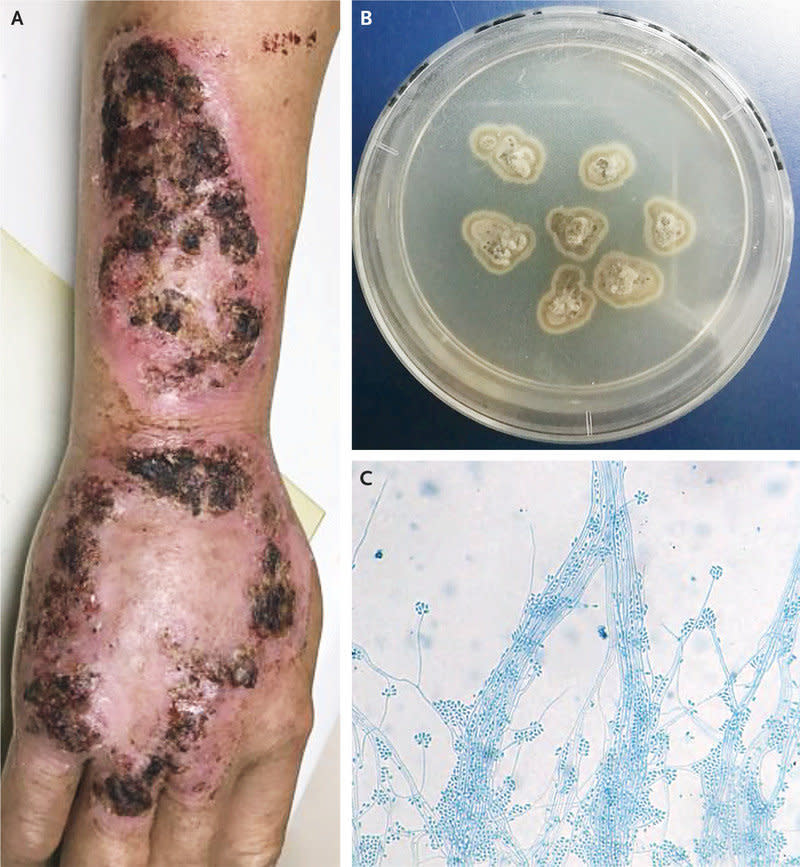What The Health?! Man contracts nasty fungal infection while gardening — but what's the risk?
Can leftover spaghetti really kill you? Can you actually cough up a blood clot in the shape of your lung? In Yahoo Lifestyle Canada‘s newest series, What The Health?!, we ask doctors to weigh in on odd health news stories and set the record straight. Be sure to check back every Friday for the latest.

Gardening hardly seems like an activity that presents much in the way of danger, save for the possibility of a sore back.
But a farmer in China found out the hard way that digging around in the dirt can be a health hazard. After cutting his hand while tending to plants, the 65-year-old man developed a crusty, expanding, ring-shaped rash that turned out to be a nasty fungal infection.
The man, whose case appears in the New England Journal of Medicine, said he first noticed the skin irritation after he cut himself doing agricultural work. The rash got bigger and bigger over a period of five months.
After his home remedy—a topical application of herbs and juices—didn’t do anything to quell the angry rash, he went to the doctor. A biopsy revealed that he had acquired a fungal culture called Sporothrix schenckii.

ALSO SEE: What The Health?! Man develops near-fatal brain infection after using cotton swab
The fungus can be found in dirt and plant matter all over the world. Although rare, it can cause an infection called sporotrichosis.
The infection is also known as “rose gardener’s disease,” because the fungus lives on rose bushes. Sporothrix schenckii can also be found on wood, hay and sphagnum moss.
If you prick your finger with a contaminated rose thorn or nick it on a piece of wood, the fungus can then enter and infect the body.
Sporotrichosis commonly follows the path of the lymphatic system, explains Dr. Monica Li, clinical instructor in the department of dermatology at the University of British Columbia (UBC).
“This often looks like a single bump on the hand, finger, or forearm at the site of injury that typically appears several weeks—up to around 12 weeks—after contact with the source of infection,” Li tells Yahoo Canada. “The bump may become larger, then become ulcerated or raw and produce pus. However, the bump is typically not painful.
“In the next several weeks, nodules or ulcers deeper in the skin can appear along the path of where our lymphatics drain—for instance, often up along the forearm,” she says. “Like all skin conditions, different presentations may appear in different individuals….For individuals who are immunocompromised, widespread infections possibly with pneumonia-like symptoms can occur.”
Besides a cut, another way of contracting sporotrichosis is by breathing in fungal spores in the air.
“The fungus may also come from animals, particularly cats in certain parts of the world—not so much in Canada—but animal-to-human transmission is uncommon,” Li adds. “Given infectious sources being vegetation and plants, those who may be at greater risk of contracting the infection may include those who work in the agriculture, horticulture, forestry or gardening fields.”
The infection can spread to other parts of the body, like the joints or central nervous system, according to the Centers for Disease Control and Prevention.
Sporotrichosis is more prevalent in those who have a weakened immune system.
“For avid gardeners, particularly elderly or those on steroids or chemotherapy, be careful and wear good gardening gloves to protect against puncture wounds,” says Karen Bartlett, UBC professor of occupational and environmental health. “For folks with compromised immune systems, it wouldn’t hurt to wear an N-95 NIOSH certified dust mask, which is available at Home Depot or pharmacies.”
ALSO SEE: What The Health?! Did this 25-year-old contract a rare autoimmune disorder from a cat?
“Note that an N-95 is not the same thing as a surgical mask, nor is it the same as a cheap dust mask,” she says. “If it is printed with the words N-95 or NIOSH, then it will protect against inhaling spores.”
There are other substances found in dirt that can be harmful to human health.
“Aspergillus fumigatus is another organism that lives in soil and also a problem for people with asthma or immune-compromised conditions,” Bartlett says.
Spores of Aspergillus fumigatus can be inhaled, to fatal effect: a 47-year-old man in England became ill and later died after opening bags of rotting plant material and being surrounded by clouds of dust.
The fungus, which is often found in compost and dead leaves, sometimes triggers a mild allergic reaction but can result in much worse if too many spores enter the lungs.
“We are usually protected by our high body temperature; fungi don’t like growing at 37 degrees Celsius and above,” Bartlett says, “but the exceptions are the few fungal genera that can and are pathogenic [disease-causing], whether inhaled or by puncture wound.
“It is also very important to keep your tetanus immunizations up to date, with a booster every 10 years, because Clostridium tetani lives in soil as well,” Bartlett says. “Wash well after puttering in soil. Dry soil is much more likely to release spores than wet soil.”
Let us know what you think by commenting below and tweeting @YahooStyleCA!Follow us on Twitter and Instagram.
Check out Yahoo Canada’s podcast, Make It Reign — our hot takes on all things royals in a non-stuffy way — on Apple Podcasts and Google Podcasts.


